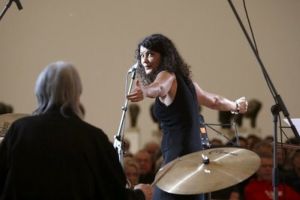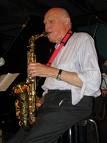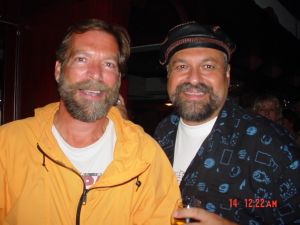main: December 2008 Archives
For years, Jack Benny opened his CBS radio and television broadcasts with "Love in Bloom." The comedian's violin butchery of his theme song became a running coast-to-coast Sunday night gag. As a result, the piece became even more famous than Bing Crosby had made it with his hit record in 1934. Generations of listeners and viewers heard Bob Hope close his NBC shows with "Thanks for the Memory," which he introduced in a movie, "The Big Broadcast of 1938." The song was inseparable from Hope's career.
Ralph Rainger, the man who wrote those songs, was a pianist and recovering lawyer from Newark, N.J., who also composed such standards as "Easy Living," "If I Should Lose You," "Here Lies Love," "Moanin' Low," "June in January," "Please" and "Blue Hawaii," most often with lyricist Leo Robin. Rainger and Robin turned out dozens of songs for Hollywood movies. They were frequently on the hit parade with Rodgers and Hart, Cole Porter and the Gershwins. George Gershwin died at age 38, Rainger at 41. But while Gershwin's fame increased after his death, Rainger's name faded. With their beguiling melodies and challenging chord progressions, Rainger's works are frequent vehicles for improvisation. Yet, in my experience, most musicians who play those songs respond with puzzled looks when asked who wrote them. That might have been the case with bassist Chuck Berghofer, pianist Jan Lundgren, drummer Joe La Barbera and the incomparable vocalist Sue Raney until producer Dick Bank recruited them to record the CD "The Film Music of Ralph Rainger" (Fresh Sound).
...it is the first all-Rainger album since pianist Jack Fina managed to reduce Rainger's tunes to dreary cocktail music in a 1950s LP. Mr. Lundgren, a brilliant Swedish pianist, plumbs the songs' harmonic souls. He illuminates even the prosaic "Blue Hawaii," which -- to Rainger's horror -- became a huge hit in 1937. "It will disgrace us," he told Robin. "It's a cheap melody . . . a piece of c-."

Freddie Hubbard, the last great trumpet stylist and innovator in jazz, has been through a miserable few years. He failed to care for an infected split lip and attempted, with characteristic Hubbard bravado, to overblow through the problem. Surgery made it worse. He told me that royalties from his compositions have brought him a comfortable living, but that not being able to play well has kept him frustrated. For him there is agony in the solution, the dogged hard work to rebuild his embouchure. Although he knows that playing long tones saved other trumpeters, he said, "Man, that sh-- is so boring." Hubbard's constitution and metabolism militate against boredom.
User, n. The word computer professionals use when they mean "idiot." ~Dave Barry
But they are useless. They can only give you answers. ~Pablo Picasso
Man is still the most extraordinary computer of all. ~John F. Kennedy
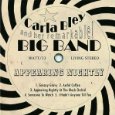
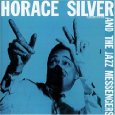
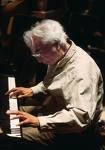 others including actors Jane Fonda and Jack Nicholson, fitness maven Jack LaLanne, musician and producer Quincy Jones, chef Alice Waters and -- posthumously -- Theodore Geiss (Dr. Seuss), scientist Linus Pauling, architect Julia Morgan, and Dorothea Lange, the photographer best known for documenting the human toll of the Great Depression.
others including actors Jane Fonda and Jack Nicholson, fitness maven Jack LaLanne, musician and producer Quincy Jones, chef Alice Waters and -- posthumously -- Theodore Geiss (Dr. Seuss), scientist Linus Pauling, architect Julia Morgan, and Dorothea Lange, the photographer best known for documenting the human toll of the Great Depression.
Brubeck turned eighty-eight on December 6. Paul Conley of Capital Public Radio in Sacramento, California, spoke with him yesterday about the honor and about his plans. To hear the conversation and see Conley's video of Brubeck, click here.
Shortly after I posted the Doug's Picks selection of Wadada Leo Smith's new CD, Tabligh (see the center column), I was in a meeting with Daron Hagen. I casually mentioned Smith. "What?" he said, full of excitement. "You know about Leo?" It turns out that Hagen, a distinguished composer of operas, chamber music and orchestral works, was a teaching colleague of Smith at Bard College and holds him in high regard. That led to a discussion of one of Hagen's -- and my -- favorite propositions, that music is music and there are only two varieties--good music and what Duke Ellington called the other kind. Hagen places Smith squarely in the first category.
Coincidentally, You Tube has just put up a video of Smith and his Golden Quartet. It is apparently from a television program, but in typical You Tube fashion the only information we get is the names of the players: Smith, pianist Vijay Iyer (misidentified as Lyer), bassist John Lindberg and drummer Ronald Shannon Jackson. Before they play, Smith speaks briefly about the nature of the blues. The piece ends inconclusively, but given the nature of the music it is difficult to know whether that is by design or because the video reached You Tube's time limit.
There is a second piece, evidently from the same program. If you watch it, I recommend setting aside preconceived notions. The music is fascinating - and wild. This also cuts off unceremoniously, an annoying feature of far too many web videos. Click here.From San Francisco comes news of the death of Frances Lynne, the singer who worked with Paul Desmond and Dave Brubeck before there was a Brubeck Quartet. Ms. Lynne went on to sing with Charlie Barnet and Gene Krupa as the big band era wound down. Her first recording, however, was not until 1991 with her husband, John Coppola's band. She and the trumpeter were married for fifty-six years. She was eighty-two years old. Reviewing her CD, Remember, I wrote, "Often discussed but seldom heard, Ms. Lynne is a charming singer."
She worked in the late 1940s at San Francisco's Geary Cellar in a group called the Three Ds in which Brubeck was the pianist. In 1949, Desmond stole her, Brubeck and bassist Norman Bates from the Three Ds leader for a job at the Band Box near Palo Alto. In Take Five: The Public and Private Lives of Paul Desmond, Ms. Lynne recalled that experience.
Oh, it was a funny little gig, just an ordinary little gig, and the people from Stanford used to come in and sit there and inspire us, especially Dave and Paul. They'd get on a kick where they'd play all these fugal things. It was just a great happy thing. When I was singing, Paul played behind me. He never got in my way. He was the kind of player who was intuitive and inspirational. He'd never do anything unmusical. He was just a sweet, sweet person. He was interested in what you said and what you thought. Everybody likes that. He was attentive and he was very, very talented. Nobody got a sound like that out of the alto saxophone.
And, you know, those little jobs at the Geary Cellar and the Band Box never seem to die. I still hear people talking about them. And I'm glad, very happy, because that's my only claim to immortality. I got a lot of offers in those days, but I wanted to stay with the group. I was like a little puppy, I was having so much fun.
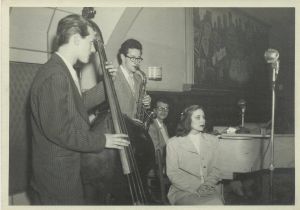
After the Band Box job ended and following her time with Krupa, Ms. Lynne worked in New York, including a spot on television, then returned to San Francisco. She and her husband kept their home there while Coppola went on the road as a member of Woody Herman's Third Herd in the fifties and later led his band in the Bay Area. She sang occasionally, always winning praise for her intonation, phrasing and sensitivity to the meaning of lyrics.
For more on Frances Lynne, see Jesse Hamlin's article in today's San Francisco Chronicle.
Among Rifftides readers in Europe are the proprietors of three web logs helpful to those who wish to keep up with developments on the continent.
Tony Emmerson's Prague Jazz concentrates on music in the Czech Republic. George Mraz,
 Emil Viklický, Frantisek Uhlir, Gustav Brom, Miroslav Vitouš and a few other Czech musicians are widely known. Emmerson (pictured) writes about them, but he also keeps tabs on the current crop of players known mainly in Eastern Europe. He sometimes stretches the definition of what many listeners consider jazz, but he's on top of developments. Here is an excerpt from a piece about a band at the new Charles Bridge Jazz Club.
Emil Viklický, Frantisek Uhlir, Gustav Brom, Miroslav Vitouš and a few other Czech musicians are widely known. Emmerson (pictured) writes about them, but he also keeps tabs on the current crop of players known mainly in Eastern Europe. He sometimes stretches the definition of what many listeners consider jazz, but he's on top of developments. Here is an excerpt from a piece about a band at the new Charles Bridge Jazz Club.
As well as a good venue a good evening requires a good band, and the Luboš Andršt Blues Band certainly falls into this category. We here at Prague Jazz are proud fans of the mighty Luboš and the musicians he usually plays with. With him for this concert were perennially funky electric bassist Wimpy Tichota, drum powerhouse Pavel Razím, and Jan Holeček on keys and vocals.
What the band delivered was three sets of hard-hitting electric blues, ranging from gospel spirituals to a rocking blast of "Cross Road Blues" (R. Johnson). Their arrangement was very close to the Cream interpretation that has become known as the definitive version to many people. Luboš's improvised solo was dazzling, while Holeček wailed the lyrics with passion. His voice is very similar to a young Robert Plant, and he could no doubt make a good living in a Led Zeppelin tribute band if he was so inclined.
Emmerson also sometimes posts photographs of Czech musicians in action, like this one of the amazing singer Iva Bittová and Mraz in a recent concert in Bern with Emil Viklický's trio.
Laco Tropp and Iva Bittová, photograph by Benno
To visit Prague Jazz, click here.
The German trumpeter Bruno Leicht (pictured) has a blog with the cumbersome name, Bruno
Leicht presents His Old & New Swingin' Dreams. He posts at irregular intervals, alternates

between German and English and devotes himself more to American jazz from the classic and bebop periods than to what is happening now in Germany. Still, he manages to unearth interesting audio clips and videos and occasionally comes up with anecdotes that make his pages worth a visit. An example: His encounter with Chet Baker.
The band seemed to be stoned which didn't seem to bother Chet. He was more worried about his horn which didn't work properly. He sat there, pushing the valves, then he grabbed the mike and asked something like: "Some trumpet player around?" I was seated right in front of him and said: "Yes!" He intended to play on my trumpet and so I fetched it from the checkroom and handed it over to him. He took it, looked at it and counted: "One, two, three, four!" into a very fast and boppish "Conception," George Shearing's masterpiece, a tune as closely connected to Miles Davis as it was to Chet Baker.
He played it in the key of C, that's what I remember. After the tune, he waved my trumpet over his head, smiled at me in a sardonic way and pretended dashing my horn in some corner. I was quite shocked but of course got the joke in the same second. This was my first real instrument, a Getzen Capri but with a little hole in the middle tube.
What do I remember yet? He played the rest of the concert on his own horn and ... he kept my valve oil. When I arrived later at home I found it gone. Chet Baker, a thief!
To check out Bruno Leicht's blog, go here.
In Russia, the editor of Jazz.Ru magazine, Cyril Moshkow (could that be his real name?)
 operates an extensive web site in Russian. But, Moshkow (pictured) tells, Rifftides,
operates an extensive web site in Russian. But, Moshkow (pictured) tells, Rifftides,
For those disadvantaged by little or no Russian, we do have a safe (however tiny) harbor in English. At least we mean it to keep our Western visitors informed on what we do, but, alas, I cannot say that we update the English section too often.
Nonetheless, the site has helpful tidbits like this:
FAQ: IS THERE JAZZ IN RUSSIA, REALLY? The answer is "YES". The first jazz concert in Russia took place in Moscow on October 1, 1922. The band was local, called no less than The First Jazz Band of the Republic, led by not a musician, but a dancer,

one Valentin Parnakh (1891-1951)(pictured), who also was a gifted poet, poetry translator, and literature historian, and spend seven years (from 1915 to 1922) in Western Europe. That band was later employed by the great theatre director, Vsevolod Meyerhold, in one of his plays where the sounds of live jazz should represent the "Western reality." The band included piano, saxophone, clarinet, trombone and a trap set. One of the musicians known to be a part of this band was pianist Yevgeny Gabrilovich (1899-1993), later a successful playwright and movie screenplay writer.
Moshkow's magazine concentrates on contemporary Russian jazz of all stripes. The current online edition in English, for instance, has short pieces on tenor saxophonist Igor Butman and the multi-instrumentalist Arkady Shilkloper, two of Russia's best-known jazz players.
We will add the web addresses of these sites to the list in the Rifftides center column of links to Other Places.
 In his Jazz Profiles blog, Steven M. Cerra's stock-in-trade is thorough examinations of the careers of important jazz musicians. His current project is Victor Feldman, the late, astonishingly talented drummer, pianist and vibraharpist. Steve just posted the third of three parts about Feldman. In the first installment, he tells of going to The Lighthouse in Hermosa Beach, California, in the late 1950s when Feldman was playing piano and vibes with the all-star group led by Howard Rumsey.
In his Jazz Profiles blog, Steven M. Cerra's stock-in-trade is thorough examinations of the careers of important jazz musicians. His current project is Victor Feldman, the late, astonishingly talented drummer, pianist and vibraharpist. Steve just posted the third of three parts about Feldman. In the first installment, he tells of going to The Lighthouse in Hermosa Beach, California, in the late 1950s when Feldman was playing piano and vibes with the all-star group led by Howard Rumsey.
As an aspiring Jazz drummer, it was late on one of the sparsely attended week nights that I summoned the courage to go up to Stan Levey, always an imposing figure, to ask him a question about some aspect of the mechanics of playing the instrument.
The band members usually congregated along the back wall of the club between sets. When I approached Stan and asked my question he replied: " you don't wanna talk to me about that sh**; I'm self-taught. The guy you want to talk to is sitting over there [nodding toward Victor sitting alone at an adjoining table]. He even knows the names of all the drum rudiments!"
At the time, I had no idea that Victor played drums. I soon found out as he thoroughly answered my question as well as demonstrating the answer. Shortly thereafter, Victor Feldman agreed to offer me lessons.
Victor Feldman, ca 1957
Cerra details Feldman's career up to and beyond his celebrated and regrettably brief time as Miles Davis's pianist. To read all three segments, click here. I suggest scrolling down to part one and working back up. Along the way, you'll find a Cerra appreciation of pianist Dado Moroni, also worth your time.
The research into Ralph Rainger that has kept me more or less hors de combat from Rifftides lately included the not entirely disagreeable task of watching The Big Broadcast of 1938. Film musicals still recycled vaudeville in those days, so what we get is a series of blackouts draped over a flimsy structure called a plot. It's an excuse to see, among other things, a few vintage W.C. Fields bits and hear Martha Raye, a drastically underrated singer. Part of the plot involves Bob Hope's character dodging three ex-wives while he pursues Dorothy Lamour.
Hope and one of the exes, played by Shirley Ross, have a drink in the lounge of a transatlantic liner. Beautifully underplayed (in contrast to the rest of the movie), the scene introduced one of Rainger's best songs and - according to Hollywood lore - reduced the crew to tears while it was being filmed. Here's why.
In the Boston Globe, Matt Negrin reports on yesterday's memorial service for pianist Dave McKenna. He includes what one of McKenna's favorite singers said about working with him.
To read all of Negrin's article, click here.It was like partially singing with an orchestra and floating on air at the same time, because he was buoyant," said Daryl Sherman, who had sung with the pianist since the 1980s, including at his final performance in the Oak Room in New York City's Algonquin Hotel. She called McKenna the "Woonsocket hero.

Rifftides readers in Rhode Island and nearby parts of New England who were friends or admirers of Dave McKenna may wish to attend a memorial service for him today, Sunday, December 7. The pianist, a mainstream jazz powerhouse for decades, died on October 18. He was seventy-eight.
The 2 p.m service will be at The St. Ann Arts and Cultural Center, 84 Cumberland Street in Woonsocket, RI, McKenna's home town. His sister, Jean O'Donnell, will sing at the service. Other singers will be Carol Sloane, Daryl Sherman and Donna Byrne. Instrumental colleagues who also worked closely with McKenna will perform to celebrate his life. Among those expected to pay tribute are Dick Johnson, George Masso, Lou Colombo, Gray Sargent, Mike Renzi, Marshall Wood, Gary Johnson and Red Lennox.
In response to last month's post Herb Geller At 80, Rifftides reader Mike Baughan sent the following account of hearing Geller under fortuitous circumstances.
On a 'post-divorce find-myself-solo vacation' to Norway in 2002, I was fortunate enough to attend some events of the Oslo Jazz Festival. Saw the Swedish guitarist Ulf Wakenius perform a lively set. At the show's conclusion they invited those interested to meet at The Oslo Grand Hotel for a jam session. Traveling alone, I had no tight schedule, so I went not knowing what it would be like.
The opening band was Herb Geller's Quartet. Many musicians finishing up their sets
around town sauntered in, with an almost devout attention to Herb's playing. Among them was Joe Lovano who stood right next to me (!) After a few minutes, I got my nerve up and asked Mr. Lovano if I could buy him a drink. In a long 5 seconds I felt like a fool for asking him, followed by his: "Well of course you can!" In return for the snifter of Courvoisier, I told him, it'd cost him a photo, which hangs prominently on this jazz fan's wall!
For the next hour, Mr. Lovano was my best friend on this earth. What a kind human being!
Most of our talk was about the state of jazz in Europe in contrast to the USA, but with an emphasis on what a strong role Herb Geller plays in that scene.
As I talked to him, Joe was approached by many other musicians urging him to go up & jam w/ Herb, but he politely declined while introducing me ("Mike from North Carolina") as his new friend. He pointed out techniques, intricacies, & nuances of Herb's playing that even I, a non-musician, could understand. Most importantly, his respect for Herb in the pantheon of jazz history was incredible.
I was enthralled! Needless to say, it's my favorite jazz fan story. Joe & Herb are both class acts in my book. Words can't express. Pardon the rant, but I'm still fascinated by that evening. Happy Birthday to Mr. Geller. Love your Desmond book. Happy Holidays.
Mike Baughan, Joe Lozano, Oslo, 2002
Thanks to Dr. Baughan for a good story well told.
 Wayne Shorter turned seventy-five in August and played a delayed celebratory concert this week in Carnegie Hall. He was with his working rhythm section of pianist Danilo Perez, bassist John Patitucci and drummer Brian Blade. The remarkable Imani Winds also played a set with Shorter. I wasn't there, worse luck, but fellow artsjournal.com blogger Larry Blumenfeld was. He filed a moving report on his Listen Good. Excerpts:
Wayne Shorter turned seventy-five in August and played a delayed celebratory concert this week in Carnegie Hall. He was with his working rhythm section of pianist Danilo Perez, bassist John Patitucci and drummer Brian Blade. The remarkable Imani Winds also played a set with Shorter. I wasn't there, worse luck, but fellow artsjournal.com blogger Larry Blumenfeld was. He filed a moving report on his Listen Good. Excerpts:
It's as if Shorter has simply liberated each song from its beginning and end, allowing each to extend and even blur into one another, free of given duration. The cliché when describing a band as strongly in sync as Shorter's is that it moves as one: But these musicians don't. And they don't follow the leader, either, beyond taking his song cues --"Zero Gravity," "Sanctuary," "Joy Rider," among a few others--and adjusting to his rhythmic and dynamic shifts.
The arrangements were like gardens that had grown over to an absurd yet startlingly beautiful point, yet somehow retained the logic of their original plantings. And even in such elaborate context, seated the whole time, Shorter was prominent without being dominant, playing upward-pointed lines, high-register squeals, well-placed single notes, and, at one point, soft blues phrases with obvious glee and no signs of slowing down.
To read all of Blumenfeld's review, click here. Now, I'm back to work on a Ralph Rainger project appearing soon in a newspaper near you.
The Rifftides staff is knee-deep, at least, in an article about Ralph Rainger. It will appear soon in a national publication. Ralph Rainger? Here are two clues:
People say you rule me with one wave of your hand. Darling, its grand. They just don't understand
You might have been a headache, but you never were a bore...
I'll get back to blogging soon. In the meantime, please explore the Rifftides archives, which now have more than three-and-a-half years of material. Time flies when you're having fun.
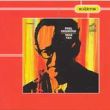 Michael Ricci, the proprietor of the All About Jazz web site, asked me to contribute (in the true sense of the word) something about "Take Ten," the piece Paul Desmond hoped would become as big a hit as its predecessor, "Take Five." Michael and I worked together to adapt a substantial portion of the chapter of my Desmond biography that deals with "Take Ten." AAJ put it up today, with a bonus in the form of illustrated audio of Desmond, Jim Hall, Gene Cherico and Connie Kay playing "Samba de Orpheu" from the Take Ten CD. By clicking here, you will find all of that, complete with a link to the publisher of Take Five: The Public and Private Lives of Paul Desmond, who would be happy to sell you a copy and throw in free shipping. Christmas is coming. The book wraps beautifully.
Michael Ricci, the proprietor of the All About Jazz web site, asked me to contribute (in the true sense of the word) something about "Take Ten," the piece Paul Desmond hoped would become as big a hit as its predecessor, "Take Five." Michael and I worked together to adapt a substantial portion of the chapter of my Desmond biography that deals with "Take Ten." AAJ put it up today, with a bonus in the form of illustrated audio of Desmond, Jim Hall, Gene Cherico and Connie Kay playing "Samba de Orpheu" from the Take Ten CD. By clicking here, you will find all of that, complete with a link to the publisher of Take Five: The Public and Private Lives of Paul Desmond, who would be happy to sell you a copy and throw in free shipping. Christmas is coming. The book wraps beautifully. The Pocono Mountains of Pennsylvania in the northeast United States are home to musicians who like peace and quiet but must be near New York City and Philadelphia, where

the work is. The Delaware Water Gap area of the Poconos has become famous in jazz circles for residents including Phil Woods, Urbie Green, Bob Dorough, David Liebman, John Coates, Jr., Bill Goodwin, Steve Gilmore and Hal Galper, and for the Deer Head Inn, the region's jazz headquarters. It was at the Deer Head in 1978 that Woods, Rick Chamberlain and the late Ed Joubert cooked up the notion that grew into the Delaware Water Gap Celebration of the Arts (COTA) and its renowned jazz camp.
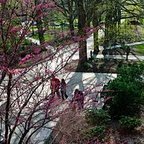 The Poconos also boast East Stroudsburg University, the site of the Al Cohn Memorial Jazz Collection. Named for the great tenor saxophonist, composer, arranger and catalyst, the Cohn collection is a historian's, researcher's and enthusiast's paradise. It is packed with recordings, oral histories, books, video tapes, DVDs, sheet music and memorabilia. The collection survives and expands with the support of those who understand the importance of its efforts to preserve the history of the music and educate people about it. Its three-times-a-year newsletter The Note would be worth reading if only for Woods' lead column, Phil In The Gap. In the Fall 2008 issue he gives an account of a recent globe-hopping tour in which he and his luggage became strangers. Phil and the bags kept playing different cities. Here's an excerpt about a night in Italy.
The Poconos also boast East Stroudsburg University, the site of the Al Cohn Memorial Jazz Collection. Named for the great tenor saxophonist, composer, arranger and catalyst, the Cohn collection is a historian's, researcher's and enthusiast's paradise. It is packed with recordings, oral histories, books, video tapes, DVDs, sheet music and memorabilia. The collection survives and expands with the support of those who understand the importance of its efforts to preserve the history of the music and educate people about it. Its three-times-a-year newsletter The Note would be worth reading if only for Woods' lead column, Phil In The Gap. In the Fall 2008 issue he gives an account of a recent globe-hopping tour in which he and his luggage became strangers. Phil and the bags kept playing different cities. Here's an excerpt about a night in Italy.
The Verona gig with was with Jesse Davis' band. Good rhythm section, but the hotel was sadder than McKinley's funeral -- even the horses cried. No clean drawers and I don't mean the dresser! The bathroom was the personification of Italian showers - no water, no curtain, no washcloth, and postage-sized towels. But the restaurant was great, of course.
Later in his column, Woods writes about COTA's educational activities and his new CD project, The Children's Suite, his composition based on A.A. Milne's Now We Are Six. The issue also has the final part of Dave Liebman's series, "Reflections on the Artistic Process" and a long verbatim oral history conversation with the late composer Manny Albam about his life and music. Each issue of The Note has several such substantive articles. When Bob Bush, the coordinator of the collection and editor of The Note, asked me to contribute something, I was delighted to write about my encounters through the years with the collection's namesake.
One morning in 1973 in Washington, DC, I was waiting to be seated for breakfast at the Airline Inn, a motel south of the Capitol near the UPI Television News bureau. Someone behind me greeted me by name. I looked back and, to my surprise, saw Al Cohn. Al and I met through Zoot Sims shortly after my family and I moved to New York in 1970. We became cordial acquaintances during my frequent visits to the Half Note, home base for him and Zoot.
It turned out that Al was in town orchestrating the score of the musical Raisin during the show's pre-Broadway shape-up. I was UPITN's chief (meaning all-purpose) correspondent, covering the White House, the Watergate hearings in Federal court and the US Senate, and traveling with President Richard M. Nixon on those increasingly rare occasions when he emerged from the bunker. For a time, I traveled to DC and spent most of every week there. I was delighted to find a kindred soul among the lobbyists, lawyers, Teamsters Union representatives and occasional--uh--professional women who populated the Airline Inn when Congress was in session.
After that initial encounter, Al and I met for breakfast every morning while he was working on Raisin. Our talks touched on his work, my work, Watergate, international affairs and whatever we had heard or read in the news that morning. His curiosity about the world ranged as wide as his humor. He had me chuckling much of the time. I'd give anything to have recordings of those conversations.
I wish that I could give you a link to the rest of the article, but The Note has no online version. The good news is that The Al Cohn Collection has a web site, where you can find out how to contribute to a valuable nonprofit organization doing good work. If you ask nicely when you send your check, there's a good chance that Bob Bush will put you on the mailing list for The Note. Click here and scroll down to "How To Donate." Tell him Rifftides sent you.
Al Cohn, ca 1973, with Al Porcino's Band of the Century
in the Rough Rider Room of the Roosevelt Hotel, NYC
© Doug Ramsey
As I pointed out here and here earlier this year in surveys of medium-sized bands,
Six to eleven pieces allow arrangers freedom that the conventions and sheer size of sixteen-piece bands tend to limit. Medium-sized groups have been important since the beginnings of jazz.
They continue to be important. Here are three recent, quite different, examples.

Felipe Salles, South American Suite (Curare Records). Salles performs on several reed instruments. He is exceptional in his tenor saxophone solos, but his writing for an octet of spirited young players is what makes this some of the most intriguing mid-sized-band music of the year. Among other elements, Salles melds Brazilian forms and bebop spirit for exhilarating blends of simplicity, complexity and sophistication. His resourceful harmonic voicings for horns and violin often make the band sound half again larger. This is music of insistency and depth. It demands and rewards attentive listening.
New Jazz Composers Octet, The Turning Gate (Motéma). The NJCO's arrangers and composers craft challenging settings for the soloists, who include themselves. The group's sparkplug, trumpeter David Weiss, has long since established himself as a forward-looking
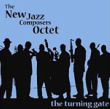
writer. Pianist Xavier Davis, bassist Dwayne Burno and saxophonist Myron Walden also contribute substantial works to this collection. Trombonist Steve Davis and tenor saxophonist Jimmy Greene grace the group, along with drummer Nasheet Waits and baritone saxophonist Norbert Stachel. All are key players in today's New York modern jazz community. Weiss's "The Turning Gate" and Xavier Davis's four-part "The Faith Suite" are rewarding new contributions to the repertoire.
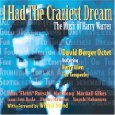 David Berger Octet, I Had The Craziest Dream: The Music of Harry Warren (Such Sweet Thunder). Many of the songs Harry Warren wrote for motion pictures were among the biggest hits of the 1930s and '40s. The dozen that Berger chose for this CD are standards that have endured for decades. His arrangements of "September in the Rain," "I'm an Old Cowhand," "Jeepers Creepers," "I Had the Craziest Dream" and the rest do Warren justice he has too often been denied. Berger's charts are idiomatic in surprising ways; "Boulevards of Broken Dreams" as a slinky tango, for instance, and "The Gold Diggers' Song" outfitted with a flying bebop soli for the ensemble. Eight fine musicians abet Berger. Saxophone soloists Harry Allen and Joe Temperley stand out, with stirring work from relative newcomers Isaac Ben Ayala on piano, trumpeter Brian "Fletch" Pareschi, alto saxophonist Matt Hong and trombonist Marshall Gilkes. Veteran drummer Jimmy Madison and the young bassist Yasushi Nakamura generate serious swing throughout.
David Berger Octet, I Had The Craziest Dream: The Music of Harry Warren (Such Sweet Thunder). Many of the songs Harry Warren wrote for motion pictures were among the biggest hits of the 1930s and '40s. The dozen that Berger chose for this CD are standards that have endured for decades. His arrangements of "September in the Rain," "I'm an Old Cowhand," "Jeepers Creepers," "I Had the Craziest Dream" and the rest do Warren justice he has too often been denied. Berger's charts are idiomatic in surprising ways; "Boulevards of Broken Dreams" as a slinky tango, for instance, and "The Gold Diggers' Song" outfitted with a flying bebop soli for the ensemble. Eight fine musicians abet Berger. Saxophone soloists Harry Allen and Joe Temperley stand out, with stirring work from relative newcomers Isaac Ben Ayala on piano, trumpeter Brian "Fletch" Pareschi, alto saxophonist Matt Hong and trombonist Marshall Gilkes. Veteran drummer Jimmy Madison and the young bassist Yasushi Nakamura generate serious swing throughout.
AJ Ads
AJ Blogs
AJBlogCentral | rssculture
Terry Teachout on the arts in New York City
Andrew Taylor on the business of arts & culture
rock culture approximately
Laura Collins-Hughes on arts, culture and coverage
Richard Kessler on arts education
Douglas McLennan's blog
Dalouge Smith advocates for the Arts
Art from the American Outback
Chloe Veltman on how culture will save the world
For immediate release: the arts are marketable
No genre is the new genre
David Jays on theatre and dance
Paul Levy measures the Angles
Judith H. Dobrzynski on Culture
John Rockwell on the arts
innovations and impediments in not-for-profit arts
Jan Herman - arts, media & culture with 'tude
dance
Apollinaire Scherr talks about dance
Tobi Tobias on dance et al...
jazz
Howard Mandel's freelance Urban Improvisation
Focus on New Orleans. Jazz and Other Sounds
Doug Ramsey on Jazz and other matters...
media
Jeff Weinstein's Cultural Mixology
Martha Bayles on Film...
classical music
Fresh ideas on building arts communities
Greg Sandow performs a book-in-progress
Harvey Sachs on music, and various digressions
Bruce Brubaker on all things Piano
Kyle Gann on music after the fact
Greg Sandow on the future of Classical Music
Norman Lebrecht on Shifting Sound Worlds
Joe Horowitz on music
publishing
Jerome Weeks on Books
Scott McLemee on books, ideas & trash-culture ephemera
theatre
Wendy Rosenfield: covering drama, onstage and off
visual
Public Art, Public Space
Regina Hackett takes her Art To Go
John Perreault's art diary
Lee Rosenbaum's Cultural Commentary
